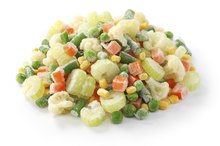Is Soup Broth Good for You?
You can consume soup broth alone, or as a flavoring for casseroles, vegetables and meats. Eating soup regularly can help you control how many calories you consume, because many types are low in calories and satisfying, according to a study published in the November 2007 edition of the journal “Appetite.” Soup broth has both benefits and drawbacks.
Types
Varieties of soup broth include vegetable, chicken, beef and fish. You make each by simmering a variety of ingredients, straining off the solids and saving the liquid broth. Vegetable broth, for example, may contain carrots, onions, garlic, celery or broccoli. A meat-based broth typically has seasonings, onions, meat bones and meat.
Calories and Fat
The Nutrition of Pho Soup
Learn More
Soup broths are low in calories. Beef, chicken and fish broths contain about 30 to 40 calories per cup, and vegetable broth contains about 12 calories per 1 cup. Vegetable broth contains no fat. A commercially prepared chicken broth has 1.4 grams of fat; beef broth contains 0.5 grams; and fish broth has 1.5 grams. The fat in chicken and fish broth is mainly unsaturated, which is a better choice for your health. About half of the fat in beef broth is saturated fat, which contributes to clogged arteries, and can lead to cardiovascular disease.
Nutrients
Although chicken, beef and fish contain healthy protein, their accompanying broths have little. While a 3-ounce serving of beef roast has 22 grams of protein, 1 cup of beef broth has just 2.7 grams. Chicken and fish broth contain 4.9 grams of protein, while vegetable broth has none. Protein aids in muscle and tissue health. All these broths have less than 3 grams of carbohydrates, making them a good choice if you are one a low-carb diet. Vegetable broth contains vitamin A, which is important for both your immune system and vision. Fish broth has 73 milligrams of calcium and 210 milligrams of potassium, while beef and chicken broth have 14 milligrams of calcium and 10 milligrams of potassium, respectively. Calcium supports bone and teeth strength, while potassium assists with cardiovascular and nerve function.
Warnings
How Many Calories are in Carrot Soup?
Learn More
Although soup broths have healthy nutrients, commercially available broths often contain 50 percent of your daily sodium allowance or more per cup. The recommendations from the American Heart Association for adults is a maximum of 1,500 milligrams of sodium per day, and chicken broth has 747 milligrams, beef broth contains 893 milligrams, fish broth has 776 milligrams and vegetable broth contains 940 milligrams. Avoid eating soup broth as your main source of nutrition, as the nutrients in the broth will not meet your needs for grains, dairy, protein, fruits and vegetables. Although most vegetables contain fiber, vegetable broth contains none.
Strategies
A healthier alternative to commercial broths is making your own soup broth, or purchasing the lowest sodium broth you can find. When boiling chicken for a casserole, add vegetables and herbs to the broth and simmer for an hour. Strain the liquid and freeze for later use. Use lean stew meat or fish meat to make your own healthy fish or beef broth. Save your leftover vegetables and simmer them in a pot of water for several hours to allow the flavors to mix thoroughly. After straining the solids from the vegetable liquid, use the broth as a base for minestrone, bean or squash soup. You can also saute vegetables in vegetable broth as an alternative to oil.
Related Articles
References
Resources
Writer Bio
Diane Lynn began writing in 1998 as a guest columnist for the "Tallahassee Democrat." After losing 158 pounds, she wrote her own weight-loss curriculum and now teaches classes on diet and fitness. Lynn also writes for The Oz Blog and her own blog, Fit to the Finish. She has a Bachelor of Science in finance from Florida State University.








